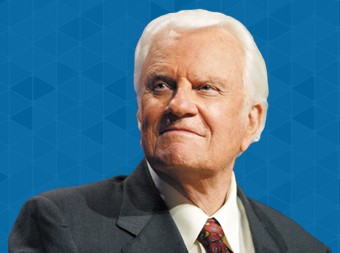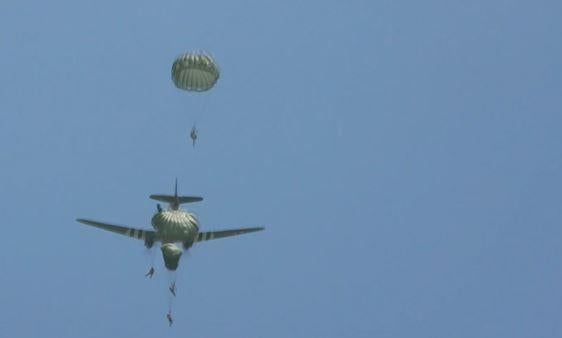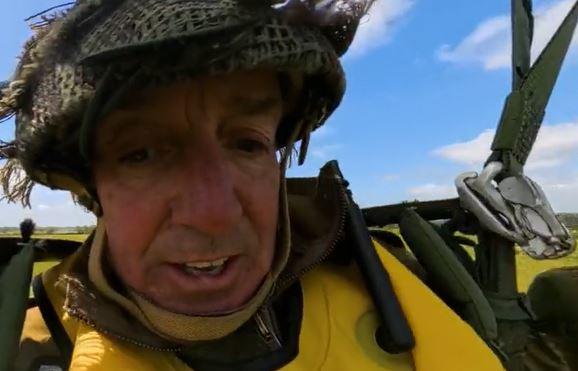| Saturday, July 27, 2024 11:19 AM GMT+1 |

Home Our Daily Bread The Good Seed The LORD is near 
Andrew Wommack 
Billy Graham 
Christian 
General 
Interesting |
|
D-Day paratroopers honored by thousands, reenacting a leap into Normandy
Posted by Temmy Wed, June 05, 2024 4:34pm
Not much has changed in the training of American paratroopers since their predecessors risked — and lost — their lives storming into Normandy nearly 80 years ago. The "parachute landing fall" is just the same: How to absorb the impact without breaking their legs. Learning how to pull out of the parachute if they're being dragged across the ground after landing remains a similar, and vital maneuver. We packed our own chutes. The slightest mistake could be lethal, so before we started, instructor Ian Marshall took us through everything that could go wrong. Each nightmare scenario for us was there for the paratroopers eight decades ago, but with an added hail of gunfire. A blown or torn canopy, tangled cords, getting tangled up with another jumper, water landings, tees, power lines — they're all real and present dangers. The last resort: Pull the reserve parachute. You might not walk away, we were told, but you will live. We headed to the Netherlands to put our training to the test. With all the drills and all the training, it's hard enough to remember what's going on. I can't imagine what it must have been like for the young people who were actually going into a war zone — having to remember all that and then face enemy fire from the moment they approached the beach. Not for me, but the smile I wore before my first practice jump was still very much a nervous one. The Cessna took to the air, packed tight with fellow jumpers. No time now for second thoughts. We got to an elevation of 2,000 feet and it was go time. No turning back now. I took the plunge. Freefall for five terrifying seconds, and then relief when I could see my parachute had opened properly. It was a thrill. Jumping out of the plane was scary, but it's quite peaceful up there afterward. There were a couple of things I got wrong, but most of them I got right, and as one of the instructors said, you can make all the mistakes you want — as long as none of them are fatal. Second practice jump didn't go so well. Trying to land, I headed straight for a ditch and a fence. I turned with the wind. Bad idea. Just cleared the hazard, but I came in hard. My third jump was even worse, sailing out of the drop zone completely. I'm starting to understand how so many paratroopers were left scattered all over Normandy that night. They were trying to hit their mark in pitch dark, under enemy fire, and the weather wasn't friendly, either. On the fourth jump, I overcorrected, falling short of the drop zone and almost hitting the runway. Finally, it was jump five. I'd need this one to work to qualify for my license. I got a knock on the back of the head as the parachute deployed violently, but I nailed the landing, inside the drop zone, finally. I had earned my wings, qualified to jump round parachutes solo — and to make the jump into Normandy. For that one, I would not be dropping out of a modern Cessna. It was as I got suited up in a replica WWII uniform and boarded the C-47 Dakota that I really started to imagine what it must have been like for those men on that day, bracing to jump into the unknown. The vast majority of the men and women taking part in the wave of jumps this week were U.S. military veterans, including many current paratroopers from 82nd and 101st Airborne Divisions. More than 13,000 paratroopers spearheaded the initial D-Day assault, carried from British bases to Normandy on more than 800 C-47s. For many, what would become known as "The Longest Day," was actually the shortest. More than 9,000 U.S. soldiers died. It gave me butterflies to imagine those young soldiers climbing aboard this plane on D-Day, not knowing what to expect, but knowing they were going to face the fight of their lives. As we crossed the English Channel for the shores of France, aside from roar of the Dakota's engines, you could hear a pin drop. And then it was go-time. I was told to jump "with vigor" out of the door, as the slip stream along a Dakota's fuselage can cause twists in a parachute. Our aircraft led the way through the skies above Carenten, the heart of the D-Day drop zones in 1944. The paratroopers 80 years ago didn't have time to think after they hit the ground, immediately setting to work to secure strategic bridges and roads, establishing a critical toehold for the Allies in occupied France. It took three days of heavy fighting for the Allies to wrest control of the territory, partly because so many troops had landed off target. The Normandy American Cemetery and Memorial, on a cliff overlooking the coastline in Colleville-sur-Mer, contains the graves of 9,388 fallen soldiers, most of whom died in the D-Day landings and the operations that followed.  Parachutists, including U.S. military veterans, jump from a U.S. C-47 Dakota aircraft over Normandy, France, during a reenactment to commemorate the 80th anniversary of the Allies' D-Day landings in Nazi-occupied France, June 5, 2024. CBS NEWS |
More From General Chat Room Archives

Six Rockets Fired from Lebanon Miss Israel, IDF Retaliates Posted on Tue, May 18, 2021 12:34pm Six rockets were fired at Israel from Lebanon Monday but fell inside Lebanese territory. The Israel Defense Forces said Monday that it retaliated with artillery fire into southern Lebanon. Air raid sirens sounded in Israeli communities near the border, and residents were told to prepare bomb...More |

Supreme Court lets ruling in favor of trans student Gavin Grimm stand in school bathroom case Posted on Tue, June 29, 2021 7:15am The U.S. Supreme Court has refused to hear a Virginia school district's appeal in a case brought by a trans-identified former high school student who sued for the right to use bathrooms and locker room facilities designated for the opposite sex. In an order list released Monday, America's high...More |
|
For enquiries, notifications and ad placement send mail to [email protected] Copyright 2012 - 2024 All Rights Reserved. Privacy Policy || Terms & Conditions |
